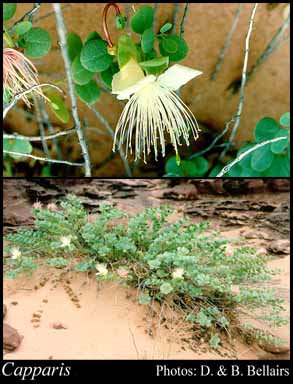- Reference
- Sp.Pl. [Linnaeus] 1:503 (1753)
- Name Status
- Current







Scientific Description
Common name. Wild Oranges. Family Capparaceae.
Habit and leaf form. Trees (small), or shrubs (erect or often sprawling and climbing); non-glandular, not resinous. ‘Normal’ plants. Leaves cauline. Stem internodes solid. Self supporting, or climbing. Xerophytic (commonly), or mesophytic. Leaves alternate; spiral, or distichous (spiral to distichous); petiolate; non-sheathing; gland-dotted, or not gland-dotted; simple. Leaf blades dissected, or entire; when simple/dissected, palmately lobed. Leaves with stipules. Stipules spiny (spines usually present but sometimes only on young or sterile shoots). Leaf blade margins often involute. Leaves without a persistent basal meristem. Leaf anatomy. Hairs present (usually), or absent; glandular hairs absent. Branched hairs present, or absent. Extra-floral nectaries absent. Stem anatomy. Secondary thickening developing from a conventional cambial ring, or anomalous; via concentric cambia (often), or from a single cambial ring.
Reproductive type, pollination. Fertile flowers hermaphrodite, or functionally male and functionally female. Unisexual flowers present, or absent. Plants hermaphrodite, or monoecious. Entomophilous.
Inflorescence and flower features. Flowers solitary (mostly), or aggregated in ‘inflorescences’; in racemes (sometimes), or in panicles (rarely). The terminal inflorescence unit racemose. Inflorescences usually in racemes. Flowers pedicellate; bracteate; ebracteolate; regular (more or less), or somewhat irregular (markedly); usually 4 merous. Floral receptacle developing a gynophore, or developing an androphore and developing a gynophore (causing the pistil to project). Hypogynous disk present; of separate members (a ring). Perianth with distinct calyx and corolla; 8; 2–4 -whorled (more or less resolvable into K2+2 and C4); isomerous. Calyx present; 4(–5); 2 -whorled; polysepalous, or partially gamosepalous (outer pair free or fused in bud); imbricate; bilabiate, or regular. Corolla present; 4; 1 -whorled; alternating with the calyx; polypetalous (abaxial pair), or gamopetalous (adaxial pair coherent at base); imbricate. Petals obovate. Corolla members not clawed. Fertile stamens present, or absent. Androecial members indefinite in number. Androecium 6–200. Androecial members branched (commonly), or unbranched. Androecial sequence determinable, or not determinable. Androecial members when branched, maturing centrifugally; free of the perianth; all equal to markedly unequal; free of one another. Androecium exclusively of fertile stamens, or including staminodes (or with staminodal branches). Stamens (6–)20–50(–200); not didynamous, not tetradynamous; all more or less similar in shape; isomerous with the perianth to diplostemonous to polystemonous; on a short torus; filantherous, or petaloid and filantherous. Anthers dorsifixed to basifixed; dehiscing via longitudinal slits; introrse; tetrasporangiate. Fertile gynoecium present, or absent (male flowers). Gynoecium 2 carpelled, or 10–12 carpelled (by dédoublement). The pistil 1–4 celled. Gynoecium syncarpous; eu-syncarpous; superior. Ovary unilocular, or plurilocular; 1 locular (usually), or 1–4 locular (sometimes, via false septa). Locules secondarily divided by ‘false septa’, or without ‘false septa’. Gynoecium when G=2 transverse. Ovary stipitate (gynophore as long as stamens or longer). Gynoecium non-stylate, or stylate. Styles 1; attenuate from the ovary; apical; shorter than the ovary at anthesis. Stigmas 1. Placentation when unilocular, parietal; when bilocular, parietal. Ovules in the single cavity 10–100 (‘many’); few to many; arillate, or non-arillate; anatropous to campylotropous.
Fruit and seed features. Fruit fleshy, or non-fleshy; dehiscent, or indehiscent (rarely); a capsule, or a berry, or a drupe, or a nut, or a samara; 1–100 celled (1 to many). Seeds endospermic, or non-endospermic. Cotyledons 2 (oily). Embryo variously curved, or bent; 1 the length of the seed, or 2 the length of the seed.
Physiology, biochemistry. Mustard-oils present.
Geography, cytology, number of species. World distribution: widespread. 650 species.
Etymology. From Greek and Latin for "caper bush", from the Perso-Arabic kabar.
Taxonomic Literature
- Grieve, B. J.; Blackall, W. E. 1998. How to know Western Australian wildflowers : a key to the flora of the extratropical regions of Western Australia. Part II, Dicotyledons (Amaranthaceae to Lythraceae). University of W.A. Press.. Nedlands, W.A..
- Wheeler, J. R.; Rye, B. L.; Koch, B. L.; Wilson, A. J. G.; Western Australian Herbarium 1992. Flora of the Kimberley region. Western Australian Herbarium.. Como, W.A..